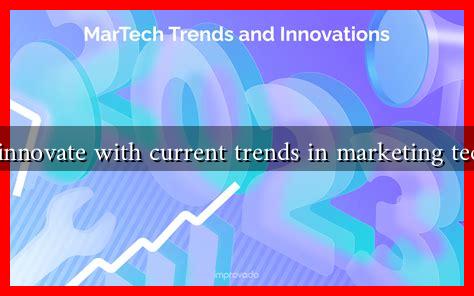-
Table of Contents
- How to Innovate with Current Trends in Marketing Technology
- Understanding Current Trends in Marketing Technology
- Strategies for Innovating with Marketing Technology
- 1. Leverage AI for Personalization
- 2. Prioritize Data Privacy
- 3. Create an Omnichannel Experience
- 4. Optimize for Voice Search
- 5. Incorporate AR and VR
- Case Studies of Successful Innovation
- Conclusion
How to Innovate with Current Trends in Marketing Technology
In the fast-paced world of marketing, staying ahead of the curve is essential for businesses looking to thrive. With the rapid evolution of technology, marketers must adapt and innovate to leverage current trends effectively. This article explores how to innovate with the latest marketing technology trends, providing insights, examples, and actionable strategies.
Understanding Current Trends in Marketing Technology
Before diving into innovation strategies, it’s crucial to understand the current trends shaping the marketing technology landscape. Some of the most significant trends include:
- Artificial Intelligence (AI): AI is transforming how businesses analyze data, personalize customer experiences, and automate marketing tasks.
- Data Privacy and Security: With increasing regulations like GDPR and CCPA, marketers must prioritize data protection while still delivering personalized experiences.
- Omnichannel Marketing: Consumers expect a seamless experience across multiple channels, necessitating integrated marketing strategies.
- Voice Search Optimization: As voice-activated devices become more prevalent, optimizing content for voice search is becoming essential.
- Augmented Reality (AR) and Virtual Reality (VR): These technologies are enhancing customer engagement by providing immersive experiences.
Strategies for Innovating with Marketing Technology
To effectively innovate with these trends, businesses can adopt several strategies:
1. Leverage AI for Personalization
AI can analyze vast amounts of data to identify patterns and preferences, enabling marketers to create highly personalized campaigns. For instance, Netflix uses AI algorithms to recommend shows based on user behavior, significantly enhancing user engagement and retention.
2. Prioritize Data Privacy
As consumers become more aware of data privacy issues, businesses must be transparent about how they collect and use data. Implementing robust data protection measures not only complies with regulations but also builds trust with customers. For example, Apple has positioned itself as a privacy-focused brand, which has resonated well with consumers.
3. Create an Omnichannel Experience
To meet consumer expectations, businesses should ensure a consistent experience across all channels. This can be achieved by integrating customer data from various sources to create a unified view of the customer journey. Brands like Starbucks excel in this area, offering a seamless experience through their app, website, and physical stores.
4. Optimize for Voice Search
With the rise of voice-activated devices, optimizing content for voice search is crucial. This involves using natural language and focusing on long-tail keywords. According to a study by ComScore, 50% of all searches will be voice searches by 2025. Businesses should consider creating FAQ pages and using conversational language to enhance their visibility in voice search results.
5. Incorporate AR and VR
AR and VR technologies can create immersive experiences that engage customers in unique ways. For example, IKEA’s AR app allows customers to visualize how furniture will look in their homes before making a purchase. This not only enhances the shopping experience but also reduces return rates.
Case Studies of Successful Innovation
Several companies have successfully innovated using current marketing technology trends:
- Sephora: The beauty retailer uses AR technology in its app to allow customers to try on makeup virtually, enhancing the shopping experience and driving sales.
- Amazon: By utilizing AI and machine learning, Amazon personalizes product recommendations, resulting in increased customer satisfaction and higher conversion rates.
- Coca-Cola: The brand has embraced data analytics to understand consumer preferences better, allowing for targeted marketing campaigns that resonate with their audience.
Conclusion
Innovating with current trends in marketing technology is not just about adopting new tools; it’s about understanding how these tools can enhance customer experiences and drive business growth. By leveraging AI for personalization, prioritizing data privacy, creating omnichannel experiences, optimizing for voice search, and incorporating AR and VR, businesses can stay ahead of the competition. As the marketing landscape continues to evolve, those who embrace these innovations will be well-positioned to succeed in the future.
For more insights on marketing technology trends, visit Forbes.

